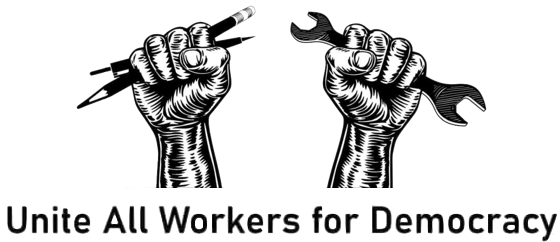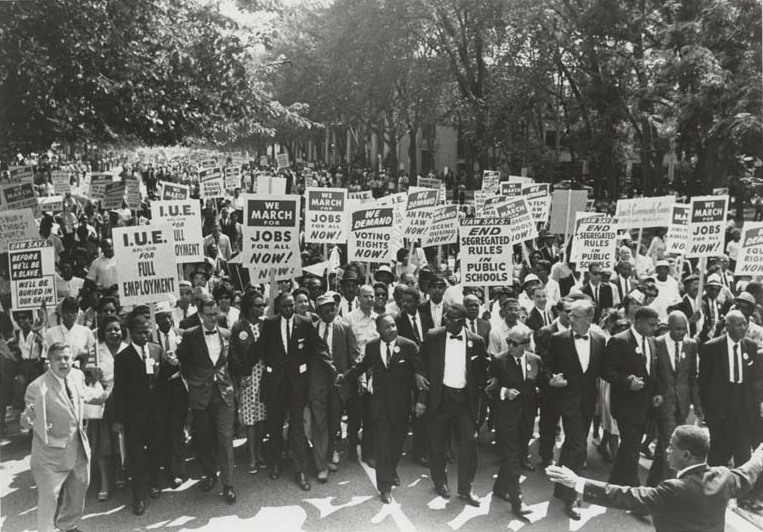Follow Erik Loomis on Twitter
Read Erik Loomis on Lawyers, Guns, & Money
Historian Erik Loomis on This Day in Labor History: August 28, 1963. The March on Washington for Jobs and Freedom takes place in Washington. Let’s talk about the forgotten economic demands on the civil rights movement that were announced on this famous day.
This famous event is of course most often remembered for Martin Luther King’s “I Have a Dream” speech, or more specifically the three lines of it that conservatives have decided justify their own positions.
But even among liberals and civil rights activists what is often forgotten or downplayed in the memory of this event is the central role economic issues played in it. Most of the economic agenda of the 1960s civil rights movement in fact is barely remembered.
That’s a huge problem because — not only were African-Americans fighting for economic advancement as well as to end segregation and for the vote — but also because it presents an incomplete history which takes away part of the reason this movement so challenged American life.
First, it’s worth noting that the original idea for the March on Washington came from a union.
In 1941, Brotherhood of Sleeping Car Porters president A. Philip Randolph called for a march on Washington to protest hiring discrimination in defense plants as the nation was gearing up for World War II.
Like most issues concerning minorities, FDR didn’t really care, but he didn’t want the bad publicity so he caved and ordered the end of hiring discrimination on government defense contracts.
This opened up a lot of jobs to African-Americans during World War II and helped build the black middle class that would do much to push forward the freedom struggle after the war.
Randolph was still active in the movement in 1963, although more as a senior figure than a major player.
But he, Bayard Rustin, and others revived the idea of the march to push John F. Kennedy to do something on civil rights, which he had been frustratingly reluctant to do. Rustin was hired to organize the event.
Rustin had been a communist in the past and that greatly worried anti-communists like the NAACP’s Roy Wilkins.
In fact, Wilkins did not even want to make a statement about the recent death of W.E.B. Du Bois at the March because he hated him for his communism. He only came around when he realized Randolph would give it and it would not be a radical speech.
But Rustin had played a role in the planning for the 1941 march and he had Randolph’s trust.
Of course Strom Thurmond used Rustin’s role to paint the entire march as a communist front and J. Edgar Hoover rejected a report showing no significant communist infiltration into the civil rights movement.
But this was just standard fare from the white supremacist American power structure.
The NAACP and most importantly Martin Luther King’s Southern Christian Leadership Conference agreed to the idea while the Student Nonviolent Coordinating Committee were happy to use the opportunity to take on Kennedy publicly and directly for his inaction.
The civil rights movement was a diverse movement with a lot of different groups and aims. That meant some careful alliance building was needed.
Among the goals the groups did agree to was a $2 minimum wage. That’s about $16 in today’s money. In other words, the Fight for $15 goes back a half century and was a core demand on the civil rights movement!!!
They also demanded federal employment law banning discrimination in public or private hiring, and the expansion of the Fair Labor Standards Act to include agricultural workers, domestic workers, and the rest of the workers excluded when the law passed in 1938.
During the March itself, Bayard Rustin read all these demands on live television, which may be the only time a list of labor demands has received that kind of coverage.
Philip Randolph led off the speeches by saying, “We are the advanced guard of a massive moral revolution for jobs and freedom” and that “the sanctity of private property takes second place to the sanctity of a human personality” in arguing for housing reform.
Playing a key role in the March on Washington was United Auto Workers president Walter Reuther. Organized labor often has a bad reputation on civil rights during this era, and mostly for a good reason. Reuther is an important exception.
This doesn’t mean he could instantly turn UAW locals into beacons of racial harmony. Turns out that racial solidarity has a lot more power with a lot more people than class solidarity and UAW officials found that out the hard way when they tried to push equality on the shop floor.
Reuther provided key labor support for the event. The AFL-CIO paid for a lot of the infrastructure of making this event happen, including the buses to get people to Washington and the UAW paid for the sound system that would blast King’s speech into history.
This all happened over the opposition of George Meany, who did not care much about civil rights before this and who opposed an official federation endorsement of the march. But the AFL-CIO did officially support the Kennedy civil rights bill.
It is said that Meany however was so moved by Randolph’s speech at the March that he created the A. Philip Randolph Institute to promote African-Americans in the labor movement.
Reuther stated in his speech, “And the job question is crucial because we will not solve education or housing or public accommodations as long as millions of American Negroes are treated as second-class economic citizens and denied jobs.”
Reuther knew that he had a friend in King because even as a lot of internationals and locals resisted the civil rights movement, King consistently supported the progressive causes of labor and frequently spoke to labor audiences.
And of course, as King went on, he became more and more focused on economic justice as a centerpiece of the larger freedom struggle, to the point of dying while supporting the Memphis sanitation workers strike in 1968.
While it’s difficult to measure the precise impact of the march on the political process so soon before Kennedy’s death, we can pretty clearly say it led to the inclusion of the Fair Employment Practices clause into what became the Civil Rights Act of 1964.
Also please notice how little a role Martin Luther King has played in this post. The March on Washington was not all about MLK — although that in no way diminishes his importance to the movement or the “I Have a Dream” speech. But it was a lot more than one man giving one speech.

